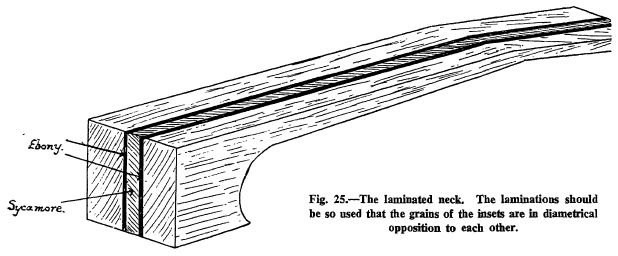Make Your Own Spanish Guitar - online book
Complete plans & Instruction on how make your own Spanish Guitar.
| Share page | Visit Us On FB |
|
23 |
|||
|
|
|||
 |
|||
|
|
|||
 |
|||
|
|
|||
|
able wood), 21" long, 3" wide and at least 3" deep.
It is best to carve the complete neck from one piece of timber but this, as will be seen, results in a lot of waste. First-class luthiers always cut a neck from the solid timber but the cheaper-made guitars often have a built-up neck, from three or more pieces. Both methods are shown in Fig. 24 (a and b).
An additional refinement is to splice the entire length of the neck. This not only gives added strength (preventing any subse�quent warping or twisting of the neck) but also gives an additional "finish" if con�trasting woods are used. (See Fig. 25.)
Once the rough shape of the neck has been cut out (or built up) the next step is to shape it roughly with a drawknife or rasp. (Refer to Fig. 24 (a) for the measure- |
ments of the finished neck and allow about 1/4" margin over these measurements.)
The head of the neck is cut to its finished shape (see Fig. 26) and faced with ebony (or rosewood). The sides of the head having been finished "square," the holes for the machine-head rollers are drilled out. (It is impossible to give measurements for this operation. The guitar maker will have to be guided by the machine-heads he has purchased. The only measurement that can be given is that the holes to take the rollers should be about 1/16" to 1/8" more in depth than the length of the rollers.)
These holes should be drilled at right angles to the sides of the head of the neck.
Next mark out the roller dots on the face of the head�and these are best cut by first drilling several holes slightly smaller in dia- |
||
|
|
|||